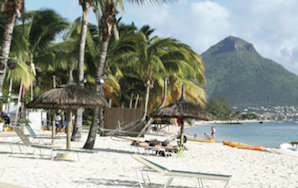The front-runners include Medine Distillery, one of the largest producers and the oldest distillery in Mauritius, having been in continuous operation since 1926 and boasting 3,300ha of sugar cane fields producing 40,000 tonnes of sugar a year.
Medine supplies other distilleries, including Green Island, with molasses and is responsible for Pink Pigeon, a light brown rum distilled from fermented molasses and blended with Madagascar vanilla, distributed by UK-based Berry Bros & Rudd. It also produces the recently released sister brand Penny Blue (see What’s New, pages 12/13).
Medine general manager Jean-Francis Koenig is optimistic about the global opportunities for his island’s rums. “There is a new dynamism in the rum business in Mauritius and we are trying to establish a Mauritian rum category on export markets which is new for us. It will take some time and effort and expense but we are confident we are going to succeed,” he says. “Our strategy for Medine is a partnership with an established, recognised company, for example Berry Bros in the UK, and we must put both capabilities together.”
From the oldest distillery to one of the newest. Rhumerie de Chamarel opened its doors in 2008 to make the most of the lifting of prohibition (the other possibility for the land had been a golf course) and has 35ha of sugar cane fields dedicated to making agricole rum. A swish visitor centre offers guided tours of the process, which involves crushing sugar cane fibres three times and filtering the liquid twice to produce rums which include a three-year-old oak-barrel matured VO, an 18-month aged Gold and a Premium White.
Sales executive Wenda Bheeka says some 45% of the annual 250,000-litre rum production at Chamarel is exported to France, Finland, Switzerland, China and Japan. “Very soon we are hoping to export to the UK and Russia, but we are not in a hurry. We are very new in our own market.”
Very much on the export trail is the premium Blue Mauritius Gold, which is currently in eight markets having only launched in September 2012. “We wanted to do something different,” says brand owner Blue Liquors managing director Frédéric Bestel. Blue Mauritius is made with molasses bought from the Grays Distillery on the island, held in port barrels for three months before going through filtration and adjustment then spending a further eight to 12 months in barrel.
“We are targetting whisky and bourbon drinkers,” says Bestel. “We exported 18,000 bottles in the first year and we’re planning 60,000 bottles next year.” And the spirit is certainly attracting attention in global markets – it picked up a nomination for Spirit of the Year at the Mixology bar Awards 2014. While it lost out in the final in Berlin, Bestel says: “We’re so proud to have been nominated – it’s like in soccer, playing the Champions League.”
Another relative newcomer to agricole distilling is St Aubin, whose 1819 brand is named for the year the plantation first became a sugar estate, with its iconic square chimney now reflected in the bottle shape. The estate prides itself on its ‘green’ credentials, being a pioneer of pot still rum agricole and being the only Mauritian distillery to use its own spring water in the coupage. It now also has a copper column still to increase production.




